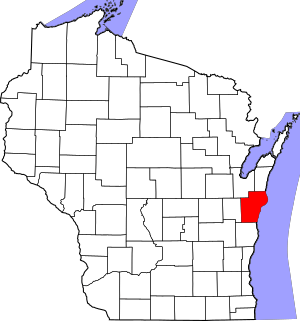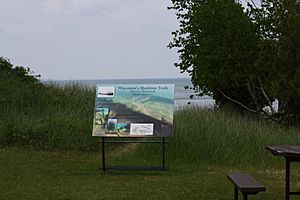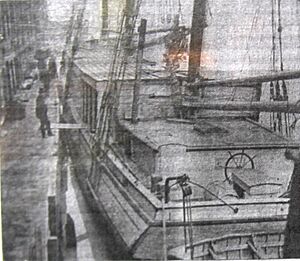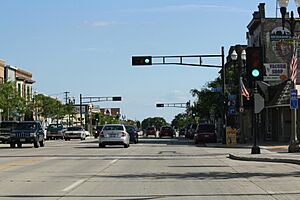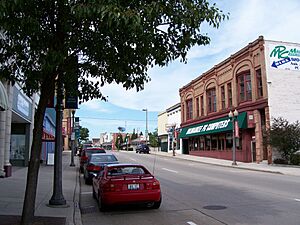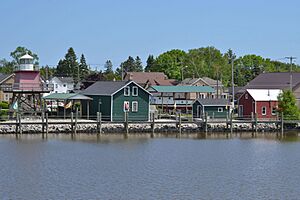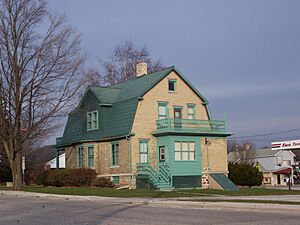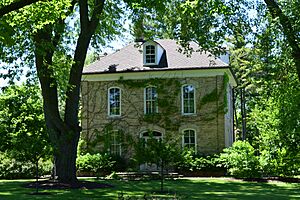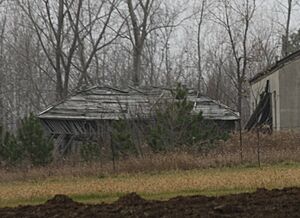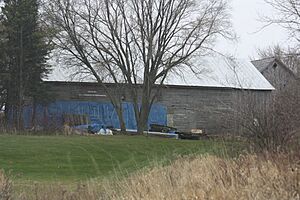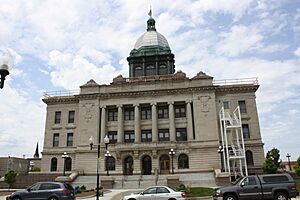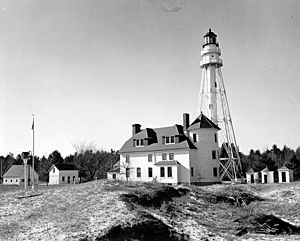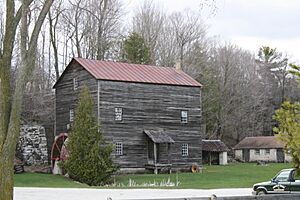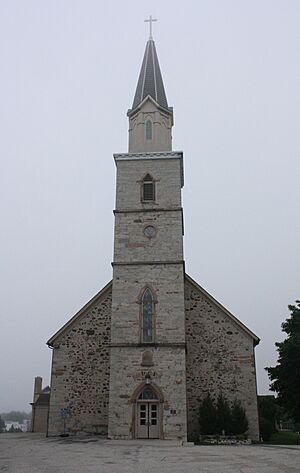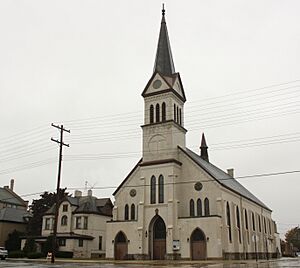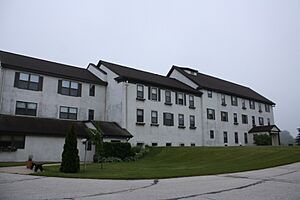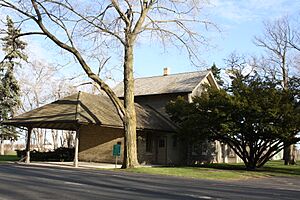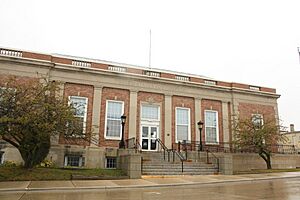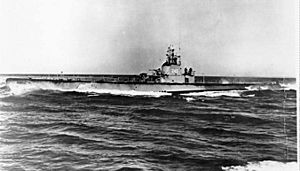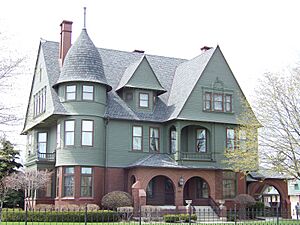National Register of Historic Places listings in Manitowoc County, Wisconsin facts for kids
Manitowoc County, Wisconsin, is home to many amazing places and things that are listed on the National Register of Historic Places. This special list includes buildings, areas, and even shipwrecks that are important to history. These sites are protected because they tell us stories about the past. You can find 37 of these cool historic spots right here in Manitowoc County!
Contents
- Explore Manitowoc's Historic Treasures
- Fascinating Shipwrecks
- Historic Buildings and Districts
- Central Park Historic District
- Eighth Street Historic District
- Frenchside Fishing Village
- Carl Gottlieb Heins House
- Charles and Herriette Klingholz House
- Loreto Shrine Chapel
- Lutze Housebarn
- Manitowoc County Courthouse
- Rawley Point Light Station
- Rock Mill
- St. Gregory's Church
- Saint Luke's Church Complex
- St. Mary's Convent
- Sexton's House
- Two Rivers Post Office
- USS Cobia (SS-245)
- Joseph Vilas, Jr. House (Rahr-West Art Museum)
- Other Historic Sites
Explore Manitowoc's Historic Treasures
Manitowoc County has many unique places that have been saved because they are so important to history. Let's explore some of these cool spots, from old ships hidden underwater to grand buildings on land.
Fascinating Shipwrecks
Lake Michigan holds many secrets, and some of the most exciting are the shipwrecks listed on the National Register. These sunken vessels offer a peek into what life was like on the Great Lakes long ago.
The ALASKA Shipwreck
The ALASKA was a type of ship called a scow schooner. It sank in Lake Michigan near Two Rivers. This wooden ship was added to the historic list in 2017, helping to preserve its story underwater.
The Continental Shipwreck
Imagine a huge wooden steamship, 244 feet long! That was the Continental, built in 1882. It carried iron and coal. In 1904, during a snowstorm, it ran aground near Rawley Point while trying to reach a dry dock for winter. Now, it rests underwater near Two Rivers.
The Floretta (Canaller) Shipwreck
The Floretta was built in 1867. It was a "canaller," meaning it was just the right size to fit through the locks of the Welland Canal. This ship carried grain and ore across the Great Lakes. Sadly, it sank in a storm in 1885 and now lies 180 feet deep southeast of Manitowoc.
The Gallinipper Schooner
The Gallinipper was an early wooden schooner, about 95 feet long, built in Ohio in 1832. It traded goods, carried passengers, and had many adventures. In 1851, it sank during a strong storm. Today, it's mostly whole, sitting 210 feet underwater near Centerville.
The Home Schooner
This small schooner was built in Portland, Ohio, in 1843. The Home first carried grain and goods on Lake Erie, then lumber on Lake Michigan. In 1858, it sank after crashing into another schooner. Its remains are now southeast of Manitowoc.
The MAJOR ANDERSON (Barkentine) Shipwreck
The MAJOR ANDERSON was a 154-foot wooden barkentine schooner built in Cleveland in 1861. It sank in a gale in 1871 while carrying coal from Erie to Chicago. Its wreck is near the Molash Creek mouth in Two Rivers.
The PATHFINDER (Schooner) Shipwreck
This large, three-masted wooden schooner was 190 feet long and built in Detroit in 1869. In November 1886, while carrying iron ore, a strong squall pushed it ashore. The PATHFINDER now sits mostly intact under 12 to 15 feet of water in quicksand near Two Creeks.
The Rouse Simmons (Christmas Tree Ship)
The Rouse Simmons is famous as the "Christmas Tree Ship"! This 124-foot schooner was built in 1868. Later in its life, it carried Christmas trees from Thompson, Michigan, to Chicago. Tragically, it sank in November 1912, and everyone on board was lost. It lies about 6 miles off Point Beach.
The S.C. Baldwin Shipwreck (Barge)
The S.C. Baldwin was a 160-foot wooden steam barge built in 1871. It first carried iron ore, then lumber and coal. It sank in Green Bay in 1903, was raised, and then sank again in Lake Michigan in 1908, sadly losing one person. Its wreck is southeast of Rawley Point Light.
Historic Buildings and Districts
Manitowoc County also has many important buildings and areas that show off different styles of architecture and tell stories of the communities that built them.
Central Park Historic District
This area in Two Rivers is the old business district. It has many cool buildings, like the Washington House Hotel (built starting in 1850) and the Richter block from 1880. You can also see the Gothic Revival St. John's Lutheran Church from 1889 and the Classical Revival Schroeder Block from 1899. There's even a Civil War Soldiers' Monument from 1900!
Eighth Street Historic District
This is Manitowoc's old downtown area. While many first floors have changed, the upper parts of many buildings still look historic. You can find interesting places like the Schultz house from 1853, the Italianate-style Berner's Hardware Store from 1857, and the Fricke/Schreihart Brewery from 1865. The Hotel Manitowoc, built in 1927, has a cool Mediterranean style.
Frenchside Fishing Village
This part of Two Rivers has been a center for commercial fishing for 167 years—longer than any other city on the Great Lakes! It includes French-Canadian homes from as far back as 1855, along with old fish sheds, ice houses, smoke houses, and net-drying racks. It's a great place to learn about the fishing history of the area.
Carl Gottlieb Heins House
Located in Kiel, this brick home was built in 1906 in the Colonial Revival style. It has a unique gambrel roof covered with decorative metal shingles. Carl Gottlieb Heins was a German immigrant who started a general store in 1861 and helped found several local businesses and the Kiel State Bank.
Charles and Herriette Klingholz House
This elegant Italianate farmhouse was built in 1868 in Manitowoc Rapids. Charles Klingholz ran a flour mill on the Manitowoc River and was an important leader in the community.
Loreto Shrine Chapel
This pink stucco chapel in St. Nazianz was built in 1870. It was made to hold a statue of Mary that immigrants brought from Baden, Germany. It's a beautiful and peaceful place.
Lutze Housebarn
The Lutze Housebarn in Newton is a very special "long" house built by German immigrants in 1850. It's unique because the family's home was at one end, and the cattle lived at the other! It was built with hand-hewn timbers in a style called fachwerk, and it's believed to be one of only three such buildings left in the U.S.
Manitowoc County Courthouse
The Manitowoc County Courthouse is a grand, three-story building with a Neoclassical style and Beaux-Arts details. It was built in 1906 and designed by Christ Tegen, a local architect from Germany. It's a very important building for the county.
Rawley Point Light Station
This lighthouse at Point Beach State Forest is truly impressive! It features a Victorian lightkeeper's house from 1873 and a tall, 111-foot skeletal light-tower built in 1894. It's the tallest lighthouse on the Great Lakes!
Rock Mill
The Rock Mill in Maribel was built in 1847 on Devil's River as a sawmill. In the 1850s, it was changed into a gristmill (for grinding grain). Much of the original grinding machinery is still inside!
St. Gregory's Church
This "Country Church Gothic" church in St. Nazianz has a towering 148-foot steeple. It was designed by Rev. Ambrose Oschwald and built in 1864. Oschwald founded St. Nazianz as a religious community for Catholic immigrants from Germany.
Saint Luke's Church Complex
In Two Rivers, this complex includes a tall Gothic Revival Catholic church built in 1891. It also has a 2.5-story Queen Anne-style rectory from 1895 and a three-story elementary school with Classical Revival influences.
St. Mary's Convent
This Greek Revival-style building in St. Nazianz was built in 1866-67 as an orphanage and hospital by Father Oschwald's community. In 1896, it became a convent when the Sisters of the Divine Savior took over. It's now called Maria Haus.
Sexton's House
The Sexton's House is a brick Italianate home with a special covered driveway (a porte cochere) built in 1878. It's located at the southeast end of Evergreen Cemetery in Manitowoc and was built to house the cemetery's keeper, called the sexton.
Two Rivers Post Office
This Georgian Revival-style post office in Two Rivers was designed by Perce Schley of Milwaukee and built in 1933. It was constructed with help from the New Deal's Public Works Administration, a program that created jobs during the Great Depression.
USS Cobia (SS-245)
The USS Cobia is a 312-foot Gato-class submarine built in 1943. It played an important role in blockading Japan during World War II. While it was built by Electric Boat Company, it's similar to submarines built by the nearby Manitowoc Shipbuilding Company. It's a National Historic Landmark!
Joseph Vilas, Jr. House (Rahr-West Art Museum)
This beautiful 2.5-story home was designed in the Shingle style and built in 1891. Joseph Vilas, Jr. was a local leader who ran a general store, shipped grain, and served as a state senator. Later, Reinhardt Rahr, a local brewer, lived here starting in 1910. Today, it's the Rahr-West Art Museum, a wonderful place to see art!
Other Historic Sites
Manitowoc County also has other important historic places, including:
- Green Bay Road Bridge: An early, one-lane iron bridge built in 1887 across the Manitowoc River. It's 150 feet long and 15 feet wide.
- Island Village Site: This is the former site of a Potawatomi village, which once had garden beds and a burial ground. It's a restricted address to protect its history.
- Mirro Aluminum Company Plant No. 3: A five-story factory built in 1929. Mirro Aluminum Company made pleasure boats here from 1958 to 1962. In 2015, it was turned into apartments for artists.


